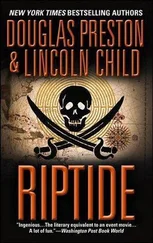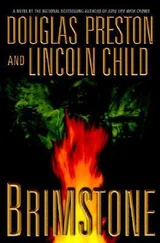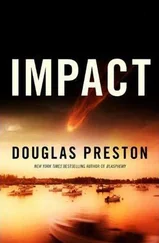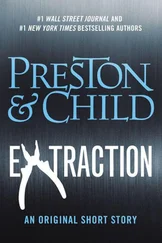The SWAT team member rose abruptly from his seat and seized Gideon’s shirt, lifting him out of his seat. “I asked you a question. Don’t look away.”
Gideon looked at him: at the engorged face, the veins bulging in his neck, the sweat popping on his brow, the trembling lips. The man looked so utterly and completely stupid, he couldn’t help himself: he laughed.
“You think it’s funny?” The SWAT guy made a fist, getting ready to strike.
Fordyce’s punch to the man’s gut came as fast as a striking rattler; he gave an oof! and fell to his knees. A second later Fordyce had him in a hammerlock. The agent bent over and spoke into his ear, in a low voice, something Gideon did not catch. Then he released the man, who collapsed on his face, groaned, and—after gasping for air—managed to rise back up to his knees.
“Sit down and be quiet,” said Fordyce.
The man quietly sat down. After a moment he began to cry.
Gideon adjusted his shirt. “Thanks for saving me the trouble.”
Fordyce said nothing.
“Well, so now we know,” Gideon went on after a moment.
“Know what?”
“That Chalker wasn’t crazy. He was suffering from radiation poisoning—almost certainly gamma rays. A massive dose of gamma radiation scrambles the mind.”
Hammersmith raised his head. “How do you know?”
“Anyone who works up at Los Alamos with radionuclides has to learn about the criticality accidents that happened there in the early days. Cecil Kelley, Harry Daghlian, Louis Slotin, the Demon Core.”
“The Demon Core?” Fordyce asked.
“A plutonium bomb core that was mishandled twice. It went critical each time, killing the scientists handling it and irradiating a bunch of others. It was finally used in the ABLE shot in ’46. One thing they learned from the Demon Core was that a high dose of gamma radiation makes you go crazy. The symptoms are just what you saw with Chalker—mental confusion, raving, headache, vomiting, and an unbearable pain in the gut.”
“That puts a whole new spin on things,” said Hammersmith.
“The real question,” said Gideon, “is the form that craziness took. Why would he claim they were beaming rays into his head? Experimenting on him?”
“I’m afraid that’s a classic symptom of schizophrenia,” said Hammersmith.
“Yes, but he didn’t have schizophrenia. And why would he say his landlord and landlady were government agents?”
Fordyce raised his head and looked at Gideon. “You don’t think that poor fuck of a landlord was a government agent—do you?”
“No. But I wonder why he kept talking about experiments, why he denied having lived in the apartment. It doesn’t make sense.”
Fordyce shook his head. “I’m afraid it’s starting to make sense to me. A lot of sense.”
“How so?” Gideon asked.
“Put it together yourself. The guy works at Los Alamos. Has a top-secret security clearance. Designs nuclear bombs. Converts to Islam. Disappears for two months. Next thing, he shows up irradiated in New York City.”
“So?”
“So the son of a bitch joined a jihad! With his help, they got their hands on a nuclear core. They mishandled it just like that Demon Core you mentioned, and Chalker got his ass irradiated.”
“Chalker wasn’t a radical,” Gideon said. “He was quiet. He kept his religion to himself.”
Fordyce laughed bitterly. “It’s always the quiet ones.”
There was a silence in the entire van. Everyone was listening intently now. Gideon felt a growing sense of horror: what Fordyce said had the ring of truth. The more he thought about it, the more he realized the man was probably right. Chalker had the personality for it; he was exactly the kind of insecure, confused person who would find his calling in jihad. And there was no other way to explain the intense dose of gamma rays he must have been exposed to, to make him so very hot.
“We’d better face it,” said Fordyce as the van slowed. “The ultimate nightmare has come true. Islamic terrorists have got themselves a nuke.”
The van doors opened into an underground, garage-like space, where they were herded through a tunnel of plastic. To Gideon, who knew their radiation exposure was probably secondary and fairly minor, it seemed like overkill, more designed to follow some bureaucratic protocol than anything else.
They were shunted into a high-tech waiting area, all chrome and porcelain and stainless steel, with monitors and computer displays winking softly from all angles. Everything was new and had obviously never been used before. They were separated by sex, stripped, given three sets of showers, examined thoroughly, asked to undergo blood work, given shots, provided with clean clothes, tested again, and then finally allowed to emerge into a second waiting area.
It was an amazing subterranean facility, brand new and state of the art, clearly built after 9/11 to handle a radiological terrorist attack in the city. Gideon recognized various kinds of radiation testing and decontamination equipment, far more advanced than even what they had at Los Alamos. As extraordinary as the place was, he was not surprised: New York City would certainly need a major decontamination center like this.
A scientist entered the waiting room, smiling and wearing a normal white lab coat. He was the first person they’d had contact with who was not in a radiation or hazmat suit. He was accompanied by a small, gloomy man in a dark suit whose size belied an air of command. Gideon recognized him immediately: Myron Dart, who had been deputy director of Los Alamos when Gideon first arrived at the lab. Dart had been appointed from Los Alamos to government service of some kind. Gideon hadn’t known him well, but Dart had always seemed competent and fair. Gideon wondered how he’d handle this emergency.
The cheerful scientist spoke first. “I’m Dr. Berk and you’re all now clean,” he said, beaming at them as if they had passed a final exam. “We’re going to have individual counseling, and then you’ll be free to resume your lives.”
“How bad was the exposure?” Hammersmith asked.
“Very minor. The counselor will discuss with each person his or her actual exposure readings. The hostage taker’s radiation exposure occurred elsewhere, not on site, and radiation exposure isn’t like the flu. You can’t catch it from someone else.”
Now Dart stepped forward. He was older than Gideon remembered, his face long and narrow, shoulders sloped. His dress was impeccable as usual: gray suit with an understated pinstripe, beautifully cut, the lavender silk tie giving him an incongruously fashionable look. He carried with him a quiet air of self-assurance. “My name is Dr. Myron Dart, and I’m commander of the Nuclear Emergency Support Team. There’s one very important thing I need to impress on all of you.” Dart placed his hands behind his back while his gray eyes perused the group, slowly and deliberately, as if he were about to speak to each person individually. “So far, the news that this was a radiological incident hasn’t leaked out. You can imagine the panic if it were to do so. Each and every one of you must keep absolutely quiet about what happened today. There are only two words you need to know: no and comment . That goes for everyone who is going to ask you what happened, from reporters to family. And they will ask.”
He paused. “You will all be signing nondisclosure papers before your release. I’m afraid you won’t be released until you sign these papers. There are criminal and civil penalties for violating the terms of the nondisclosure, spelled out in the documents. I’m sorry, but this is the way it has to be, and I’m sure you’ll understand.”
Читать дальше












